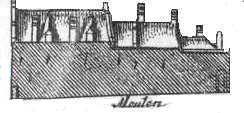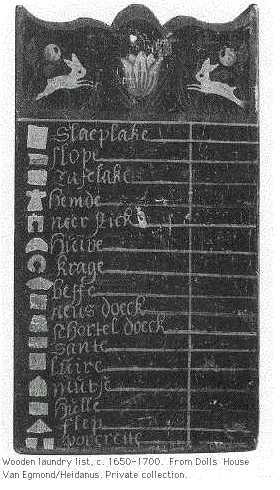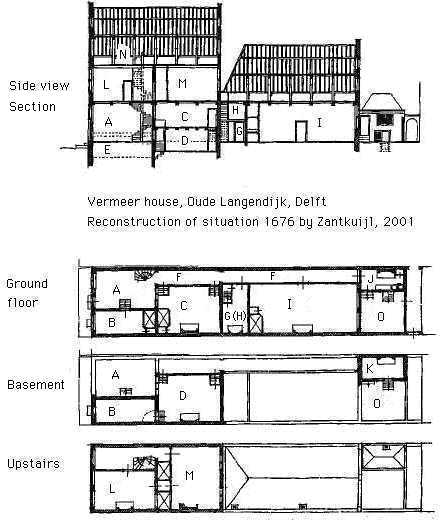1676 Inventory of movable household goods,
written down by a notary's assistant in the rooms in Vermeer's home at Oude Langendijk - corner
Molenpoort alley, a few months after Vermeer died.
 Inventory
written February 29, 1676 by the assistant of the Notary
public J. van Veen, in the house on Oude Langendijk Delft, corner
Molenpoort, of the painter Johannes Vermeer who had died a few months before. Vermeer's studio is indicated here as room L. The
original document is kept in the Delft Municipal archives. The
notary's assistant walked through all the rooms in the house and
noted the objects on two pages per room. These pages have been
combined here, identified by colour. Text shown here
in pink was the lot intended for Catherina
Bolnes. These are followed by the objects from the next
document concerning goods in purple
which were a lot jointly for Catherina
and her mother, Maria Thins. The
signature shown below is from a document dated January 10, 1654. Text
between [___] has been added by the author.
Inventory
written February 29, 1676 by the assistant of the Notary
public J. van Veen, in the house on Oude Langendijk Delft, corner
Molenpoort, of the painter Johannes Vermeer who had died a few months before. Vermeer's studio is indicated here as room L. The
original document is kept in the Delft Municipal archives. The
notary's assistant walked through all the rooms in the house and
noted the objects on two pages per room. These pages have been
combined here, identified by colour. Text shown here
in pink was the lot intended for Catherina
Bolnes. These are followed by the objects from the next
document concerning goods in purple
which were a lot jointly for Catherina
and her mother, Maria Thins. The
signature shown below is from a document dated January 10, 1654. Text
between [___] has been added by the author.
 Go
to the Dutch / Nederlandse
text of the 1676 document.
Go
to the Dutch / Nederlandse
text of the 1676 document.
See the original documents from the Delft Archives. Goods owned by
Catharina Bolnes, page 1,
page 2, page 3,
page 4, page 5,
page 6, page 7.
Goods jointly owned by Catharina Bolnes and Maria Thins, page
1, page 2,
page 3, page 4,
page 5, page 6.
Specification
"Specification of all the household and
movable goods that Catharina Bolnes, widow of the late Sr. Joannes
Vermeer, living on the Oude Langendijck, at the corner of the
Molepoort, has coming to her in possession, which goods are deposited
in the aforementioned housing.
Specification of all such household goods
and fumiture ("inboel") as Juffr.
Maria Thins, widow
of the late Reynier Bolnes, and her daughter juffr.
Catharina Bolnes, widow of Joannes Vermeer,
each to the true extent of one-half, having coming to them, which
goods are deposited in the house of the aforenamed widow on the Oude
Langendijck, in this town, on the corner of Molenpoort.
In the forehouse
("voorhuys") Room A
A small fruit painting; A small seascape; A
small landscape; A painting by [Carel] Fabritius;
A cabinet of jointry work; A large painting
of Mars and Apollo in a bad black frame; Two paintings somewhat
smaller; Four more paintings with bad frames; A mirror with an ebony
frame; A wooden footbench; Four bad green chairs; Two bad
tapestry-covered cushions.
In the Great Hall ("groote
zael") Room I
A painting representing a peasant barn;
Another painting; Two paintings, being "tronien"
[faces] by [Carel] Fabritius; One wherein three
pumpkins and other fruit; Two portraits of Sr. Vermeer's late father
and mother. Three small drawings for the mantlepiece with black
frames; A drawn coat-of-arms of the aforenamed Sr. Vermeer with ebony
frame; A pair of green serge [woolen] curtains with a pelmet
[valance] in front of the bedstead. A mantlepiece covering of
the same material. A striped curtain. Iron armor with helmet; A pike;
A lead hat fringe/edge [?]
A cabinet of joinery work with inlaid ebony;
An oak pull-out table; A little oak chest; Nine red-leather Spanish
chairs; Three green sit-cushions; A green tablecloth; an ebony wood
crucifix; Ten portraits of the lineage of the aforenamed juffr. Tins
all with bad black frames; A painting representing the Mother of
Christ in an oak frame; One more painting of the three Kings
[Magi].
 Linen
and wool. A "toers" [silk and wool material] mantle of
the aforesaid late Sr. Vermeer; a ditto "inocent" [short men's
jacket]; A pair of "toers" [silk and wool material]
trousers; A white satin skirt; A ditto yellow; A white satin bodice;
A yellow satin mantle with white fur trimming; An old green mantle
with white fur trimmings; Juffr- Vermeer's ash-gray travel mantle of
Mrs. Vermeer; A black "toers" [silk and wool material]
short jacket; A black woolen cloth women's dress
["tabbert"]; A black under dress [belonging to the
former dress]; Twelve bedsheets, both good and bad; Twenty-two
ditto pillowcases large and small; Five damask tablecloths [with
St Andrew's crosses]; Nine napkins; Twenty-one children's shirts
both good and bad; Two women's [night] shirts; 28 bonnets; 11
small children's collars; 17 pocket handkerchiefs; Two
"labaertjens" [woman's sholder coverings]; Seven pairs
of muffs; Three white caps; Three children's apron clothes; Two
morning coats; Ten men's ruffs; Thirteen pairs of fancy
cuffs.
Linen
and wool. A "toers" [silk and wool material] mantle of
the aforesaid late Sr. Vermeer; a ditto "inocent" [short men's
jacket]; A pair of "toers" [silk and wool material]
trousers; A white satin skirt; A ditto yellow; A white satin bodice;
A yellow satin mantle with white fur trimming; An old green mantle
with white fur trimmings; Juffr- Vermeer's ash-gray travel mantle of
Mrs. Vermeer; A black "toers" [silk and wool material]
short jacket; A black woolen cloth women's dress
["tabbert"]; A black under dress [belonging to the
former dress]; Twelve bedsheets, both good and bad; Twenty-two
ditto pillowcases large and small; Five damask tablecloths [with
St Andrew's crosses]; Nine napkins; Twenty-one children's shirts
both good and bad; Two women's [night] shirts; 28 bonnets; 11
small children's collars; 17 pocket handkerchiefs; Two
"labaertjens" [woman's sholder coverings]; Seven pairs
of muffs; Three white caps; Three children's apron clothes; Two
morning coats; Ten men's ruffs; Thirteen pairs of fancy
cuffs.
A wooden coffer painted green with iron
fittings; A bad metal frame bed ["ledicant"] with a
green fringed band on it; A round table top; A "viermande"
[basket in which stood a container with hot coals, used for
drying babies' nappies etc]; A little rack; A high pewter can; A
tin chafing dish; Two copper snuffers; An iron candleholder; Seven
glass flasks; Three roemers [wine glasses]; Twelve
earthenware plates; Furthermore other earthenware of little
importance.
An oak table; A child's bed with a long
matress (used for sleeping sitting up); A head pillow; A green lined
blanket. Two paintings; A trunk top painted red; A pair of bad green
curtains; A ditto mantelpiece coverlet; Two old tapestry-covered
sit-cushions; A bad mirror; Two toddler chairs with braces; Two
private document containers ; Five earthenware shell-shaped dishes;
Another five pieces of earthenware; Three Cologne butter pots; Eleven
earthenware jugs with pewter lids; A copper mortar with a pestle; A
copper candlestick; A copper bedpan; A tin butterpot; A tin ladle
with a wooden handle.
A large painting representing Christ on the
cross; Two "tronie" paintings done by [Samuel van]
Hoogstraten; A painting wherein all sorts of women's stuff
["vrouwentuych"]; One of Veronica. Two "tronie"
paintings in Turkish fashion; A little seascape ; A painting hanging
in front of the mantelpiece; A (painting) in which a bass viol with a
skull has been painted; A pair of striped curtains; A little
sideboard; Two brown footstoves; About seven ells [yards] of
gold tooled-leather on the wall.
A bed with a head mattress or long head
pillow; Three ear cushions; Two blankets being one green and one
white; a bedcover; An octagonal oak table; An oak chest; A coat rack;
Three chairs; Three green sit-cushions; A striped cloth.
An iron grill; A tin salad colander; A
hamper for storing vessels; An old lantern.
A peat chest; a board for hanging jugs; An
iron spit with its parts; a wooden spit with all its parts; a copper
pancake pan; a copper bed pan; a copper kettle; two copper pots; a
copper milk pan; four iron pots; an ironing iron.
A pair of striped curtains with a valance; A
food cupboard; A wooden rack; Three blue sit-cushions with fringes;
Four tin porringers ["eetkommitgens"]. Two pewter dishes; Two
pewter beer mugs; An iron band; A tongue; A shovel for ashes; A tin
flat candlestick; Twenty-one shell-shaped dishes.
A bed with a long head pillow; Two ear
cushions; Two blankets, one green and one white; A bed cover; A rug;
A small red-painted table; A coat rack; A potty chair; A striped
mantelpiece coverlet; Six old chairs; An old beer jug.
Two spinning wheels; A cradle.
In the hallway corridor. Room F
Two racks on which to dry linen; A wicker
basket; A wooden cutting board.
A bed with a long head pillow. Two ear
pillows; Two blankets, one being green, and one white; A bed cover; A
painting of Christ on the Cross; A painting representing a woman
wearing a necklace; Three bad chairs; A wooden trestle.
Six tapestry-covered chairs; A painting with
a gilded frame; A painting with an oakwood frame; A little mirror.
In the yard. See space O
A pewter chamber pot; Ten pewter spoons.
Three pewter chamber pots; A copper
kettle.
A chest painted red; A foot rest; Two meat
tubs; 5 or 6 old books; Three small paintings in black frames; an old
suitcase wherein seven copper candle holders; A small copper kettle;
An iron grill; A prongs, Three iron "slicklepels"
[=?].
Two tapestries; a long low wicker basket
with a high back, in which the mother can nurse her baby (bakermat) ;
a painting of a "trony"; A cupid; Two chairs; Two copper
chafing dishes ; five books in folio; another 25 books of all kinds;
Two eartherware dishes.
six paintings; ten needlework sit cushions;
a mirror; two chests [of the crate type]; a hall-stand
[for coats]; a suitcase ; two copper kettles.
Two Spanish chairs. A cane with an ivory
knob on it. Two painter's easels; Three palettes. Six panels; Ten
painter's canvases. Three bundies with all sorts of prints, a
lectern; Here and there some rummage not worthy of being itemized
separately.
An oak pull-out table with its table top; A
wooden cabinet wth drawers.
A stone table to grind colours on, along
with the stone; A wicker cradle; 13 Clothes hangers.
The above-standing goods were recorded by
me, notary, admitted by the Court of Holland, at the behest of the
aforementioned widow, who declared having acted in good faith in
presenting, and if anything were to occur to her that she had
forgotten, she will supply this amplifcation at any time. In token
whereof, signed by her. Delft, the last day of February 1676.
Catharina Bolnes.
Thus the notary which has signed underneath
has described the beforementioned goods - - - - Bolnes- - who
declared to have been of good faith, without having held back
anything knowingly, by which token it waa signed by her in Delft the
last day of Febr. 1676. Catharina
Bolnes"
The last text reflects the "oath on the inventory"; she
had to swear and consecutively undersign that according to het
best knowledge all goods were listed and nothing was left out. By
logical reconstruction we do however find quite some 'holes in
this cheese', being missing
items.
Go to the full Menu of art history tours.
Technical terms and explanations about dress, fabrics and fashion see the Dutch version of this page. Go
to the Dutch / Nederlandse
text of the 1676 document.
Zantkuijl reconstruction-drawing. Legend.
|
NEDERLANDS - DUTCH, 1676
|
ENGLISH EQUIVALENT
|
FLOOR PLAN, 2001
|
|
|
|
|
|
Int Voorhuys
|
Forehouse
|
Zantkuijl A
|
|
Inde groote zael
|
Great hall
|
Zantkuijl I
|
|
Int Camertie aende voorz. groote zaal
|
Small room adjoining the Great Hall
|
Zantkuijl G
|
|
Inde binnenkeucken
|
Inner kitchen
|
Zantkuijl C
|
|
Int agter keukentgen
|
Back kitchen
|
Zantkuijl J
|
|
Inde koockeucken
|
Cooking kitchen
|
Zantkuijl D
|
|
Int waskeukentgen
|
Washing kitchen
|
Zantkuijl K
|
|
Inde gang
|
In the hallway
|
Zantkuijl F
|
|
Op de keldercamer
|
Room above the cellar
|
Zantkuijl B
|
|
Op de plaets
|
In the yard
|
Zantkuijl O
|
|
Opt hangkamertgen
|
In the small hanging room
|
Zantkuijl H
|
|
Boven op de agtercamer
|
Upstairs back room
|
Zantkuijl M
|
|
Opde voorkamer
|
Upstairs front room
|
Zantkuijl L
|
|
Boven op de solder
|
In the attic
|
Zantkuijl N
|
|
[Niet op lijst:
Kelder]
|
[Not listed:
Cellar]
|
Zantkuijl E
|
|
[Niet op lijst:
Wenteltrap]
|
[Not listed: spiral
staircase]
|
-
|

The Dutch version of this page has an additional dictionary.
Go
to the Dutch / Nederlandse
text of the 1676 document.
Note. This text is based upon the original
Dutch text as published by Van Peer, in "Drie collecties", Oud
Holland (1957) pp. 98-103. This new English translation has been
checked against that of the largest language dictionary of the world,
the Woordenboek der Nederlandsche Taal (WNT), which was
started in 1882 by De Vries and Te Winkel.
Information on textiles was kindly provided
by art historian Marieke de Winkel (2001). The translation was newly
made and then compared to the existing translation in Montias,
"Vermeer and his Milieu" (1989) which does contain a number of
errors, especially in the description of garments.
Literature: José de Kruif,
Liefhebbers en gewoontelezers, Leescultuur in Den Haag in de
achttiende eeuw, Walburg Pers, Zutphen, 1999, p. 72.
This page forms part of a large encyclopedic site on Delft. Research by Drs. Kees Kaldenbach (email). A
full presentation is on view at johannesvermeer.info.
Launched December, 2002; Last update March 1, 2017.
Back to the Welcome page: click Welcome.
Thanks to industrial engineer and web-wizard ir. Allan Kuiper for his
wonderful navigator and 3D movies.
 Inventory
written February 29, 1676 by the assistant of the Notary
public J. van Veen, in the house on Oude Langendijk Delft, corner
Molenpoort, of the painter Johannes Vermeer who had died a few months before. Vermeer's studio is indicated here as room L. The
original document is kept in the Delft Municipal archives. The
notary's assistant walked through all the rooms in the house and
noted the objects on two pages per room. These pages have been
combined here, identified by colour. Text shown here
in pink was the lot intended for Catherina
Bolnes. These are followed by the objects from the next
document concerning goods in purple
which were a lot jointly for Catherina
and her mother, Maria Thins. The
signature shown below is from a document dated January 10, 1654. Text
between [___] has been added by the author.
Inventory
written February 29, 1676 by the assistant of the Notary
public J. van Veen, in the house on Oude Langendijk Delft, corner
Molenpoort, of the painter Johannes Vermeer who had died a few months before. Vermeer's studio is indicated here as room L. The
original document is kept in the Delft Municipal archives. The
notary's assistant walked through all the rooms in the house and
noted the objects on two pages per room. These pages have been
combined here, identified by colour. Text shown here
in pink was the lot intended for Catherina
Bolnes. These are followed by the objects from the next
document concerning goods in purple
which were a lot jointly for Catherina
and her mother, Maria Thins. The
signature shown below is from a document dated January 10, 1654. Text
between [___] has been added by the author. Go
to the
Go
to the  Linen
and wool. A "toers" [silk and wool material] mantle of
the aforesaid late Sr. Vermeer; a ditto "inocent" [short men's
jacket]; A pair of "toers" [silk and wool material]
trousers; A white satin skirt; A ditto yellow; A white satin bodice;
A yellow satin mantle with white fur trimming; An old green mantle
with white fur trimmings; Juffr- Vermeer's ash-gray travel mantle of
Mrs. Vermeer; A black "toers" [silk and wool material]
short jacket; A black woolen cloth women's dress
["tabbert"]; A black under dress [belonging to the
former dress]; Twelve bedsheets, both good and bad; Twenty-two
ditto pillowcases large and small; Five damask tablecloths [with
St Andrew's crosses]; Nine napkins; Twenty-one children's shirts
both good and bad; Two women's [night] shirts; 28 bonnets; 11
small children's collars; 17 pocket handkerchiefs; Two
"labaertjens" [woman's sholder coverings]; Seven pairs
of muffs; Three white caps; Three children's apron clothes; Two
morning coats; Ten men's ruffs; Thirteen pairs of fancy
cuffs.
Linen
and wool. A "toers" [silk and wool material] mantle of
the aforesaid late Sr. Vermeer; a ditto "inocent" [short men's
jacket]; A pair of "toers" [silk and wool material]
trousers; A white satin skirt; A ditto yellow; A white satin bodice;
A yellow satin mantle with white fur trimming; An old green mantle
with white fur trimmings; Juffr- Vermeer's ash-gray travel mantle of
Mrs. Vermeer; A black "toers" [silk and wool material]
short jacket; A black woolen cloth women's dress
["tabbert"]; A black under dress [belonging to the
former dress]; Twelve bedsheets, both good and bad; Twenty-two
ditto pillowcases large and small; Five damask tablecloths [with
St Andrew's crosses]; Nine napkins; Twenty-one children's shirts
both good and bad; Two women's [night] shirts; 28 bonnets; 11
small children's collars; 17 pocket handkerchiefs; Two
"labaertjens" [woman's sholder coverings]; Seven pairs
of muffs; Three white caps; Three children's apron clothes; Two
morning coats; Ten men's ruffs; Thirteen pairs of fancy
cuffs.